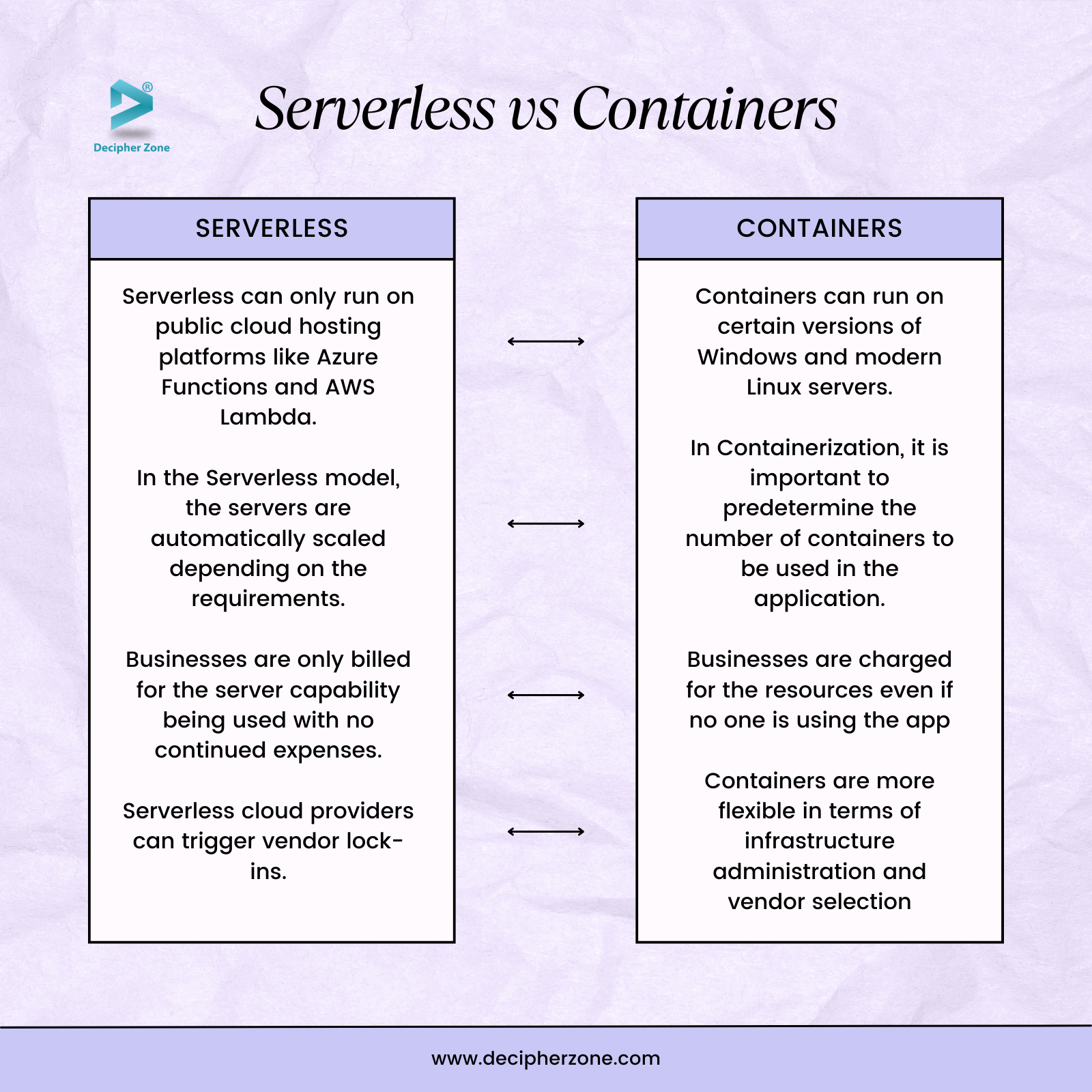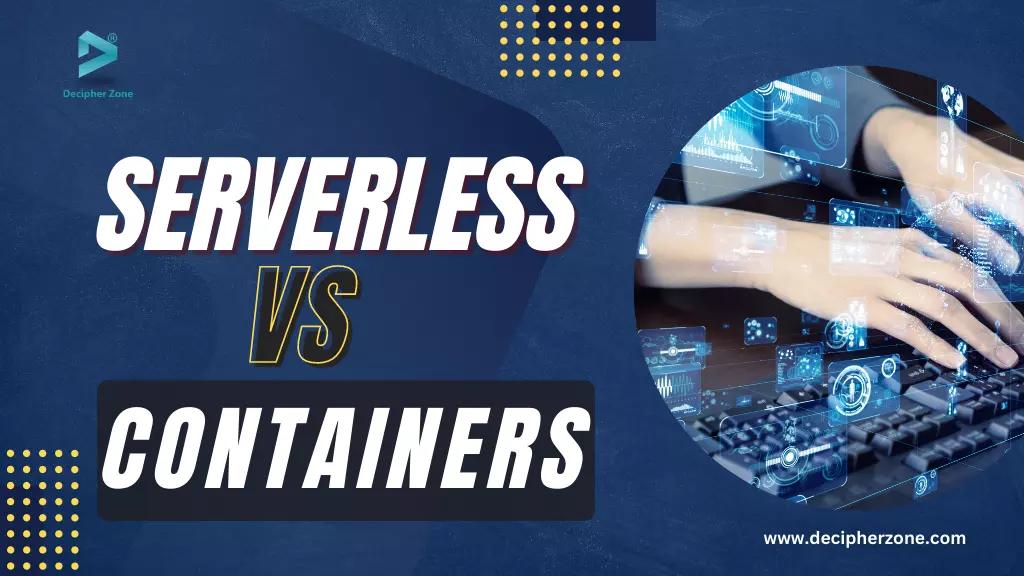Serverless vs Containers: Which One to Choose for software development? With this blog, you will learn their differences, advantages, and disadvantages, making it easier to opt for the right one.
To keep ahead of the competition, businesses around the world are looking for tools and technologies that can accelerate software development and deployment.
And when it comes to cloud computing, two of the major approaches to deploying apps are containers and serverless. Needless to say, both serverless and containers have gained popularity in the software industry due to the flexibility and robustness they offer.
But, it can still be confusing to choose the one that best suits your business needs if you don’t have the right knowledge.
Serverless vs Containers: Which One to Choose?
Serverless vs Containers: Which One to Choose? So, to help you opt for the ideal deployment method for software development, we will explain everything you need to about the overview, advantages, disadvantages, and differences between serverless and containers.
An Overview of Containers
Containers are lightweight packages of application code and dependencies such as runtime environments and libraries required to run a software service. With containers, it becomes easier to share resources like memory, CPU, storage, processors, and network at the operating system level.
In short, containers offer a logical packaging system where the entire application can be abstracted from the environment they run on. Containers allow operating system virtualization, enabling it to run in any environment. Modern containerization is expressed in system containerization - Linux Containers (LXC), OpenVZ, Linux vServer, etc., and in application containerization - Docker, CRI-O, Amazon’s Elastic Container Service (ECS), etc.
Read: What is Serverless Web Application Development
Advantages of Containers
-
Containers provide higher portability, allowing apps to seamlessly run across different environments such as in the cloud, on-premise, or developer’s laptop to ensure consistency and minimize compatibility risks.
-
Containers offer a clear responsibility separation, allowing developers to focus on the dependencies and logic of the application, and operation teams to focus on application deployment and management.
-
Containers provide efficient resource utilization leading to optimized performance and minimized costs.
-
By virtualizing memory, storage, CPU, and network resources at the OS level, containers offer developers a view of logically isolated OS from other applications.
-
With containers, developers get the agility they need to develop applications more quickly by easily avoiding environment and dependency concerns.
Disadvantages of Containers
-
As containers share the same host kernel, it can pose a security risk to other containers if one container is compromised. However, the risk can be easily mitigated by network segmentation and container isolation.
-
It can be a complicated and complex task to set up and manage containers in large-scale environments. To overcome this, you can always use container orchestration tools like Kubernetes that simplify the process.

What is Serverless?
Serverless is a cloud deployment model where developers are assigned to build and run the application without worrying about server management. Despite being named serverless, servers are still used in this model but the developers need not know them.
Read: How to Deploy Microservices Using Serverless Architecture
In the serverless computing method, businesses get backend services on demand. That is, any business that opts for serverless services from vendors is charged on a usage basis as they don’t have to pay a fixed number of servers and bandwidth, as the service offers auto-scaling capabilities.
Advantages of Serverless
-
Serverless allows developers to focus on building and running applications without having to stress about dealing with servers. Though the servers are involved in the serverless model, it comes under the vendor's responsibility.
-
As businesses only need to pay for the services and functionalities they use in serverless, it effectively reduces the overall development costs of the project.
-
While server-based apps can fail with a sudden increase in traffic, serverless allows auto-scaling to meet expectations effectively.
-
Serverless decreases the latency of the application by using servers that are close to the end-user.
-
Serverless makes it easier to modify and update a single function without impacting the overall application performance.
-
By supporting event triggers, serverless becomes a great option for sequenced workflows and deployment pipelines.
Disadvantages of Serverless
-
One of the major drawbacks of the serverless model is cold start latency. This means when a function gets triggered after a long period of inactivity, there might be a delay in sending a response as the environment is initialized.
-
With serverless, several server management aspects get abstracted, i.e., you have limited control over the underlying architecture. Although at first, it might seem like an advantage, it can also be quite challenging, especially when the application has certain hardware and software requirements.
-
Serverless can indeed be cost-effective, but it can also be uncertain in terms of costs. Especially in highly dynamic applications with fluctuating workloads, it can be difficult to predict costs accurately. Costs can spiral out of control without proper monitoring and management.
Fundamental Differences Between Serverless and Containers
Serverless v/s Containers? Some of the major differences that you might come across between containers and serverless are as follows:
-
Supported Host Environments
-
Scalability
-
Cost
-
Ease of Deployment
-
Portability
-
Vendor Lock-ins
Supported Host Environments:
While Containers can run on certain versions of Windows and modern Linux servers, Serverless can only run on public cloud hosting platforms like Azure Functions and AWS Lambda.
Scalability:
In Containerization, it is important to predetermine the number of containers to be used in the application. On the other hand, in a Serverless model, the servers are automatically scaled depending on the requirements.
Cost:
As Containers run consistently, businesses are charged for the resources even if no one is using the app. However, in Serverless, businesses are only billed for the server capability being used with no continued expenses.
Ease of Deployment:
Deploying Container-based apps is easier as you only have to package and move them to any server without stressing about compatibility issues. You can also use orchestrated tools like Kubernetes to deploy and manage containers.
Read: Advantages of Using Docker for Microservices
On the other hand, Serverless apps do not need any infrastructure provision but FaaS providers with limited features. These apps are deployed using a portal offered by a cloud provider or command line interface.
Portability:
You can move one container to another with minimal effort as they are built to be scalable, resilient, and portable. As the Serverless app is tightly coupled with the infrastructure of the provider, it does not offer much portability.
Vendor Lock-ins:
Containers are more flexible in terms of infrastructure administration and vendor selection, reducing the risk of vendor lock-ins. However, as the developers highly rely on the services and infrastructure of serverless cloud providers, it can trigger vendor lock-ins.
Read: How Docker Container Works
Which One to Choose: Serverless or Containers?
Well, there is no right or wrong when it comes to serverless and containers. But, choosing one between both highly depends on your business use case. You can opt for serverless if you need higher scalability, agility, and cost-effectiveness, for event-driven applications, or backend processing.
On the other hand, containers are best suited when you want consistency, reliability, scalability, and portability. Containers are best suited for microservices, legacy app modernization, and continuous integration and continuous deployment.
Read: What is Container Security and How to Secure Containers
So, if you want to develop a serverless or container-based application for your business or have any questions regarding the same, then get in touch with our experts. They will provide you with all the required information and share a customized quote for the project based on your unique business needs.
FAQs: Serverless vs Containers
What are the factors that differ between serverless and containers?
The differences between serverless and containers are based on supported host environments, scalability, cost, ease of deployment, portability, and vendor lock-ins.
Is serverless better than containers?
Serverless can be a better choice if you want to develop event-driven applications or for backend processing. However, containers are ideal for microservices, legacy app modernization, and continuous integration and continuous deployment.
In what scenarios should you avoid serverless?
If you want to configure the underlying infrastructure of the application, then you should not go for the serverless model as you only get limited control there.

